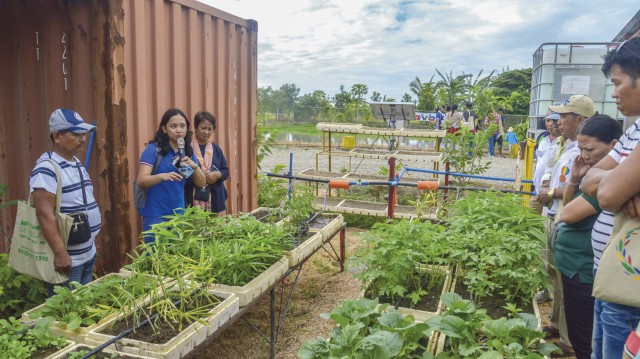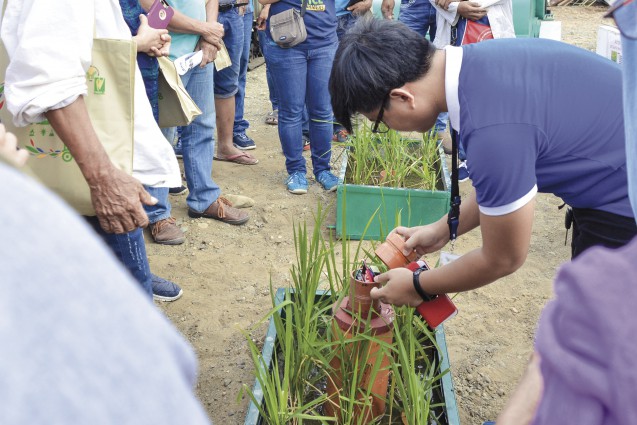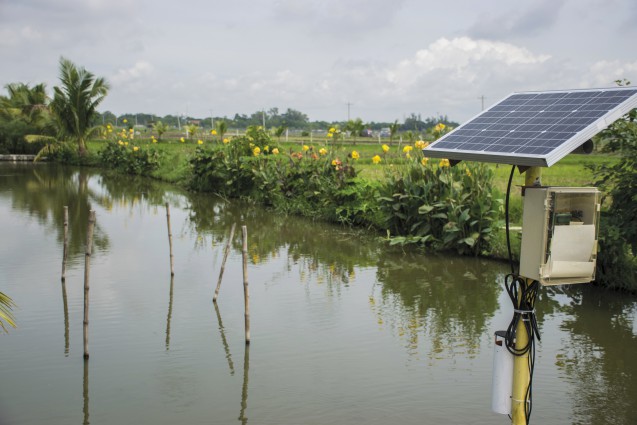Under the unforgiving heat of the lenten sun, the farmer is drenched in his sticky perspiration as he goes back and forth to the field to check if his rice crop is being dehydrated. However, because he can’t afford to lose even a cavan of his potential harvest, he’ll irrigate his field and sweat it out even if it takes more than a thousand steps to reach his field.
According to Dr. Bas Bouman of IRRI, about 2,500 L of water is needed to produce a kg of rough rice. But with irrigation water becoming scarce at times, it is important to also develop technologies that optimize limited water resources without decreasing yield while providing convenience.
PhilRice and its partners are going the extra mile in advancing these technologies through modern Information and Communications Technologies (ICTs).
Automated Drip Irrigation System
Drip irrigation system (DIS) allows water to drop slowly and rhythmically to the plant’s root system or soil surface using a network of pipes and valves. Looking at it as an efficient method, researchers from PhilRice are creating an automatic version of the system. It uses a 1-m3 water tank to irrigate small-scale vegetable plots.
Like AutoMonPH, the automatic DIS will provide real-time information so farmers can decide when and how much to irrigate their farms. It measures soil moisture levels using a pre-defined moisture range, and analyzes which areas need water. If it detects that the soil is dry, the system opens the valves to start irrigating the plots. Water flows from a water tank through the pipes installed. If the soil is wet enough, the dripping stops.
Powered by solar energy, it has two modes: auto and farmer. In auto mode, the system becomes fully automatic and decides when, where, and how much water to release. Farmer mode allows the farmer to command the system through SMS.
“Once the farmer replies in the system, the valve of the water tank will automatically open and the water will start dripping from the pipes to the vegetable plots until soil moisture climbs to 90%,” illustrated Maelyn Reselva, an electronics and communications engineer and codeveloper of the technology archetype.
ICT expert and co-developer Nehemiah Caballong, said the system is being designed for food producers who have work other than farming.
“Some professionals want to grow crops but do not have much time to physically manage them. Through this water sensor, we can monitor soil moisture and manage irrigation even in our homes or offices,” he said.
The system was tested on the 5-ha FutureRice demonstration farm.
WateRice/Automon PH
PhilRice and IRRI work in tandem on the project Water-Efficient and RiskMitigation Technologies for Enhancing Rice Production in Irrigated and Rainfed Environments (WateRice). Funded by the DA-Bureau of Agricultural Research, it aims to increase production and reduce inputs through the development, dissemination, and adoption of appropriate crop management technologies.
One of the banner technologies of WateRice is the Automated Monitoring (AutoMonPH) system capable of remote water-sensing. It is hinged on the principles of Alternate Wetting and Drying (AWD), a technology scientifically proven to save water by 16-35% without compromising yield. AWD can be practiced using an observation well to manually monitor the water status in the field to determine when to irrigate it.
“Farmers have seen the advantages of using AWD on their farms. However, some of them find AWD too laborious to use because it needs manual field observation. To “pamper” farmers, developers of the technology are working to automate it. AutoMonPH hopes to provide real-time data to help farmers decide when and where to irrigate,” explained Engr. Kristine S. Pascual, one of its researchers.
The system will allow busy farmers to monitor field water level in real time right from their homes or offices. It operates through sensory objects using a wireless network to gauge water level and automatically sends information to a central database that can be used to determine which areas need to be irrigated. It even alerts farmers about their fields’ water level via SMS.
At PhilRice, the project is led by Dr. Manuel Jose C. Regalado with a counterpart at IRRI.
Water-impounding Facility
A fellow can also create a waterimpounding facility to manage and maximize water availability. Its main job is to harvest rainwater and store it for use during the dry season.
Caballong said the FutureRice team is into automating this facility to remotely manage water distribution. It is now equipped with water sensors to monitor acidity level and conductivity.
But wait, there is more. The FutureRice Farm creations do not only provide moisture for crops but also amusement for visitors who can try fishing and kayaking. With reports from Steven Matthew H. Sajonia and Elah Camille A. Bonilla







